Transit Ideas Worth Copying From DART
Yesterday I posted about the visibility of the DART (Dallas Area Rapid Transit) headquarters and store, today I want to share some other items I liked about their transit service on my short visit last month.
Posted Schedules for bus & train
Knowing when a bus or train will arrive is important information to know. Having this information available at the point where you’d catch the bus or train would be incredible. For many riders of DART they have such information, those of us that use Metro in St. Louis can only fantasize having.
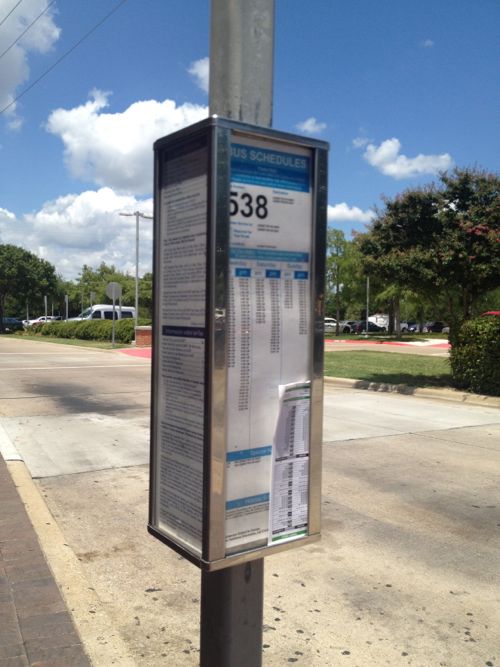

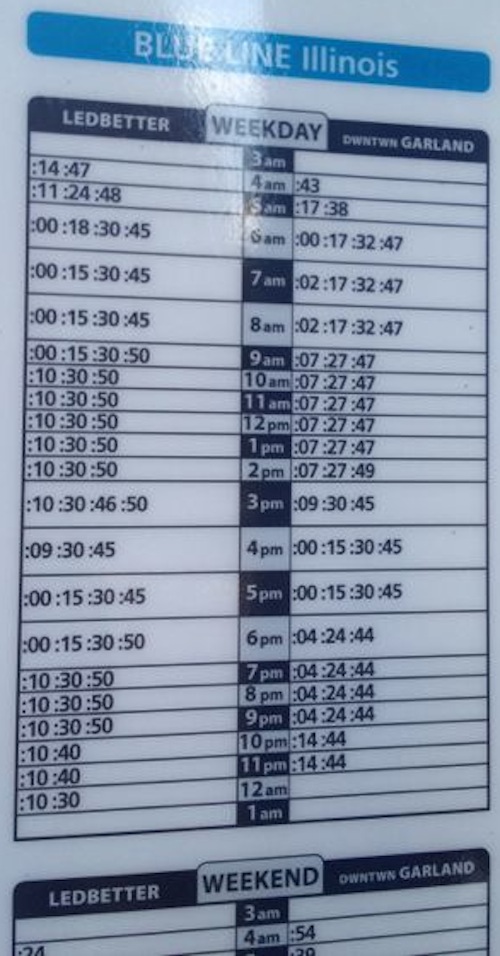
Additional Cars Added to Light Rail
DART increased capacity of their light rail vehicles in a very creative way:
DART is updating its fleet of 115 light rail vehicles (LRV) by inserting a new, low-floor insert between the existing sections of the vehicle adding seating capacity and improving access through level boarding. The newly modified vehicles began service on June 23, 2008 with car #151.
Known as Super Light Rail Vehicles (SLRV) because of the greater length and added passenger capacity, the SLRV will seat approximately 100 passengers compared with 75 on the current vehicles. Standing passengers on the vehicle can nearly double the capacity. (DART)
They’ve had to modify stations, something we [may] not be able to do.
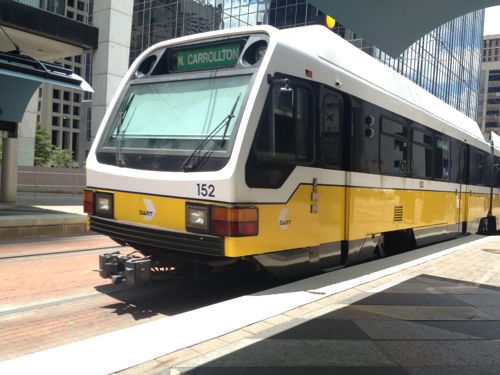
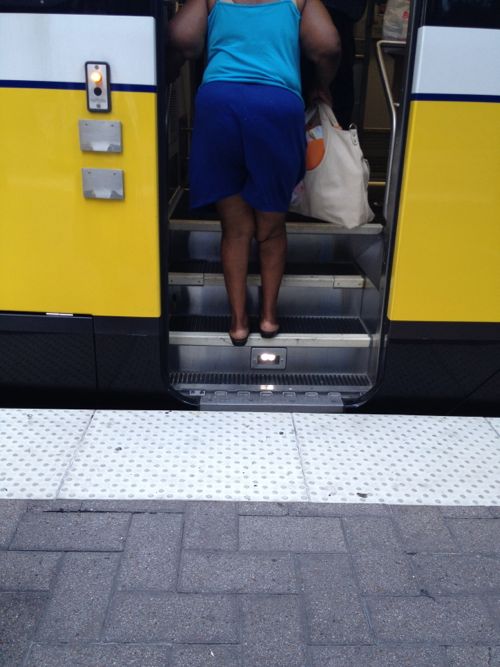
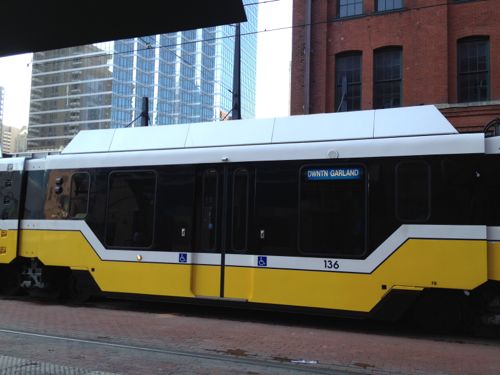
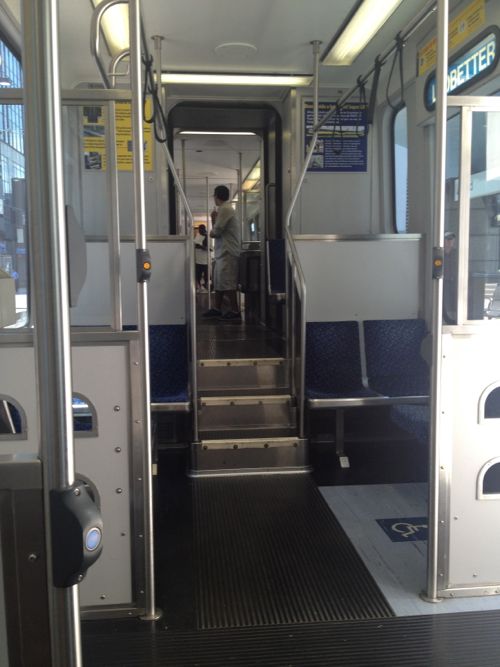
Bike Rack on Light Rail
Besides the easy boarding for wheelchairs I like the space to hang bikes in the newer low-floor cars. The seating in these is arranged facing inward rather than to the front or back, this gives more floor area and more standing room.
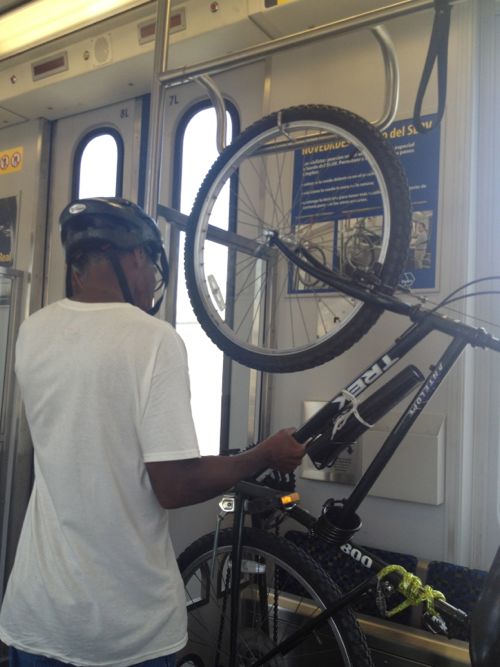
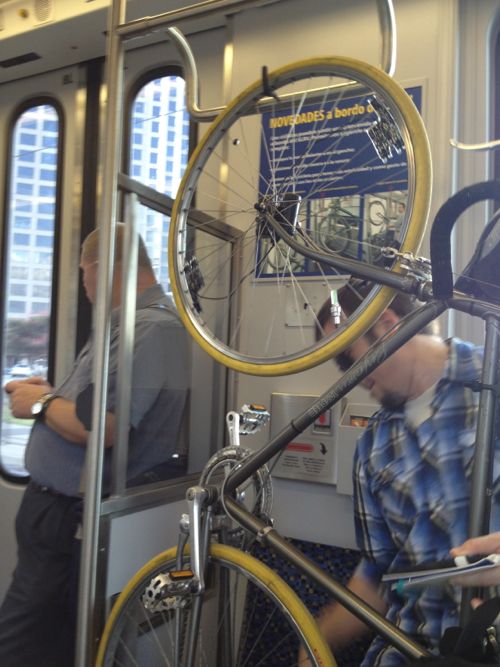
Final Thoughts:
It’s good to look to see what’s being done in other cities to see what might be good to use at home. I rode several light rail lines and two bus routes in my 30 hours in Dallas, I’d like to return with more time.
The bus vehicles were different than ours but no major surprises. The wheelchair lifts didn’t seem as robust as our lifts but I didn’t get dropped.
— Steve Patterson
As far a schedules go….I like the San Francisco model, no schedules. Buses just follow their route and all you need to do is check your cell phone (or computer) to see where on the route they are and you can plan accordingly. Works brilliantly. In this way you don’t have buses running off schedule.
Not everyone has access to a smart phone or a computer when they’re waiting for a bus.
Actually, the best model is no schedules because they run so frequently that schedules become irrelevant. We only worry about the schedule when we know that missing a bus or a train means waiting for “too long” for the nest one to arrive. Whether that’s 2 minutes, 5, 10, 20, 30 or 60 depends on the individual and the circumstances.
True. Chicago train/bus stops don’t have the full schedules, instead they simple show the average time between arrivals and lists the variances based on rush hours, peak service times and down times. For instance, during peak times when more trains are in service it lists “5 to 7 minutes.” For regular service, it’s “12 to 18 minutes.” And under late night/Sunday service, it might have “18 to 24 minutes.”
Then, of course, you have helpful transit apps like “Red Eye” which allows you to select any train station, bus line, or intersection to view exact times (whether an average guess or through GPS, i’m not sure — but probably GPS).
“They’ve had to modify stations, something we not be able to do.” Huh? You/we can do anything with enough time and money. If we wanted to enlarge our existing stations, we could do so, just like we decided to bury the light rail line between Clayton and Wash U!
Bigger picture, yes, we’re constrained by stations that can accommodate only 2-car trains, unlike other cities that can accommodate much-longer combinations. But since we run our trains relatively infrequently, we do have the option of increasing frequency, and thus, capacity, without changing the existing stations. The real advantage of longer vehicles is that one operator can move more people. But until we get that level of demand, we seem to be doing OK with our current 2-car trains.
As for DART and their low-floor inserts – yes, that’s a good solution to their problem, but it’s not one we have. With our high platforms, all doors are accessible, with no steps for any passengers. It does make it more challenging to build our stations, however. I do like their bike racks and schedules.
“The real advantage of longer vehicles is that one operator can move more people.”
Depends on the length. A bus might on average have 10 passengers, while a MetroLink train might have 50 passengers. If so then operator costs per passenger are 80% lower on the train, so not much money is saved by allowing the operator to move even more people.
Gets into arguing the various productivity issues – average load, peak load, capital costs, personnel costs, fuel costs, etc, etc. While there are differences in what operators of different types of equipment are paid, they’re not that significant. The most cost-effective way to move people is to pack ’em in. The least cost-effective way is a taxi or a limo. (And, unfortunately, the next-least-cost-effective way is the demand-responsive small buses that the ADA requires.) But the other half of the equation remains demand – the only time I’m aware of large numbers of riders being left behind is on Metrolink after big events, and in those situations, being able to to load 4 (or more) cars at one time, instead of just 2, would be great, especially if special trains could be brought in every 3-5 minutes.
I’ve always thought schedules would help, I want to know when the next bus is coming. frequent riders know there lines schedule, but I feel the the idea of not knowing when the next bus is coming keeps infrequent riders with other forms of transportation from catching the bus. also a small map with transfers on the route would help new rider also.
I agree with the tone of these posts about DART; something about that system says “easy-to-use”, which I don’t get from Metro. I was honestly shocked that in conservative Texas (although Dallas is a fair bit more liberal) that they would have a substantial, easy-to-use transit network.
Schedules would be really great, especially if combined with route maps. The city where I lived in the Netherlands also had “nearby sights” listed in relevant areas, showing how to get to museums/etc. near the stops.
is the transit riders union doing anything about getting some schedules posted?
The three challenges to posting schedules (and maps) at bus stops are keeping them current, keeping them specific and keeping them unvandalized. The three issues are interrelated. Paper schedules are easy to change but also easy to vandalize. Most bus schedules are presented as a matrix / grid, showing multiple stops; most riders just want to know when the next bus will be getting to that specific stop (which Metrolink already does do at most of its light rail stations). The DART method of separating hours and minutes (as shown in your second photo) is a good, clear way of doing things, but depends on consistency between peak and off-peak service, as well as not changing things, even slightly, every 3 or 6 months. Finally, vandalism is an unfortunate fact of life on any urban transit system. Say it costs $20 to print and post a schedule at one bus stop. Do we do it one time in a year? Twice? Three times? Once a month? Is it worth $240? $300? $500? Extrapolate that out to 1,000+ bus stops. $240,000? $300,000? $500,000?
JZ mentions the best solution, frequent transit so that you do not have to think about transit times. In cities that have successful transit, that is how it is done, especially in the most traveled areas. For secondary routes it is a question of the organization of the system so that transit users understand where they are going. In a fractured system like St. Louis you are required to know many routes to get around. And forget being spontaneous.
The timing of routes becomes less important if you have numerous alternatives from your station to get to your destination. Cities that offer those alternatives do best with transit. In St. Louis transit stops are isolated islands at best.
Scheduled times only serves to paper over the real problem of the design of transit for users.
The solutions of Metro and various government entities like East West Gateway are technical and have nothing to do with integrating transit with city planning and community needs.
The colossal failure urban planning and St. Louis University at the Grand Avenue transit is a perfect example of dysfunctional government.
I hate to bring it up again, but the whole approach in this area around Grand Ave station is current and epitomizes why transit in St. Louis does not work. All of the transit signs in the world would not make a difference. Signage would help, but it ignores the real problems.
to the thousands of people that ride the bus everyday, including myself, it works
That’s not really the question – the two real questions are how to allocate scarce resources and how (and whether or not) we should attract more riders and to convince existing riders to ride more than they do now? The core, most basic function of public transit is to move people from point A to point B. While conveying information (posting or providing schedules) is a part of the process, it’s a very minor part. The internet has evolved into a flexible, inexpensive way to convey this information, more efficiently than either looking at printed schedules or calling for information, and should be maintained and improved.
The question on the table is how to bring more information to individual bus stops (Metrolink rail stops seem to be being well-managed currently). I do know that Metro is close to rolling out new bus stop signage that will address some of these concerns. One new component will be a unique identifier that will be assigned to each stop and posted on each sign. This will allow people with a means of communicating electronically to access real-time information specific to that location.
The challenge with posting printed information at any bus stop is that it needs to be both accurate and current. Metro has to decide if no information is better than bad information. Metro has over 1,000 bus stops. It’s certainly possible to create a crew dedicated to maintaining accurate schedules at each stop, but it could easily equal the cost of operating an existing route. It comes down to choices – would you be OK if Metro decided to cut (one of) your route(s) in order to afford putting schedules at every stop on all other routes?
Finally, in a perverse way, there is absolutely no direct incentive for Metro to attract more riders. Every bus trip is 75%+ subsidized by the taxpayers, and that subsidy is static and finite – it doesn’t go up if more riders show up demanding service. While there would be more revenue on the fare side, and possibly a higher fare-recovery ratio from packed buses, it won’t come near to providing enough revenue to put more service on the street (so why make it more attractive or easier to use?!).